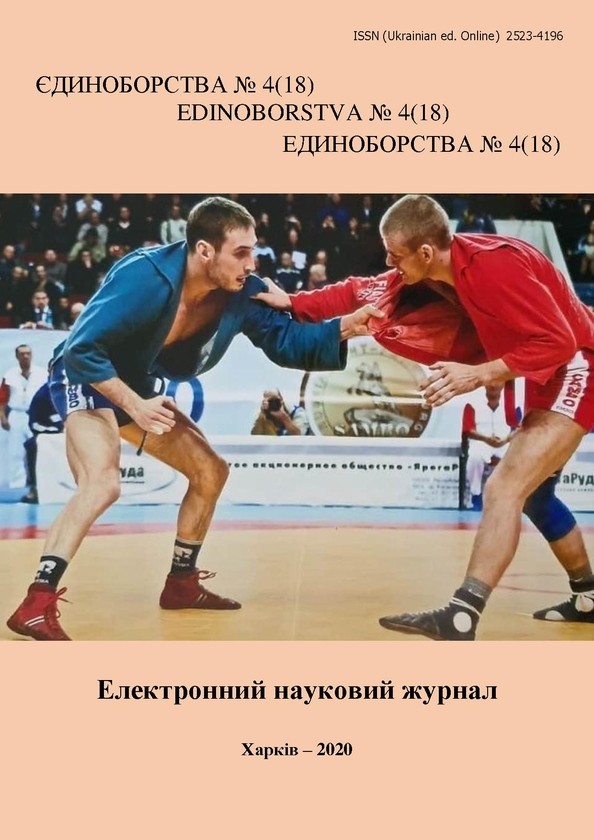The dynamics of performance indicators of combat activity in epee fencers 10-12 years old under the influence of the author's program
DOI:
https://doi.org/10.15391/ed.2020-4.02Keywords:
fencing, young epee fencers, techniques, combat actions, trainingAbstract
Purpose: to establish the dynamics of indicators of combat effectiveness in swordsmen 10-12 years under the influence of the author's program. Material and methods. The study involved 20 fencers, aged 10-12 years. Classes in the group were conducted in the amount of 8 hours a week. The study lasted one academic year. Research methods: analysis of scientific and methodological literature, pedagogical research, pedagogical observation, pedagogical testing, method of expert evaluations (evaluation of combat effectiveness), methods of mathematical statistics. Results: with the help of the selected tests, the levels of general and special physical fitness of young epee fencers were determined. The problems and features of the formation of the combat repertoire of 10-12 years old epee fencers at the stage of basic training are considered. The methodology for increasing the level of effectiveness of competitive activity by increasing the intensity of training sessions has been developed. The program is supplemented with distance learning tools. A program of work is proposed in weekly and yearly cycles. The assessment of the dynamics of the effectiveness of the combat arsenal of young fencers under the influence of the developed program is carried out. Conclusions. in the indicators of both groups, there were positive changes in the tests of general (p<0,01) and special (p<0,001) physical fitness. The difference between the groups (p<0,05) in most tests proves a positive tendency to improve the results in the experimental group. Although in the test «Shuttle run 4x9 m» (p˃0,05) and in the performance of effective attacks (p>0,1) there were no significant changes between the indicators of the groups, in general, positive changes were observed. The effectiveness of the developed program in relation to the quality of the combat repertoire has been proved. This is confirmed by the reliable dynamics of changes in the results of young epee fencers of the experimental group (EG) in the performance of combat actions: the number of counterattacks, effective attacks and effective counterattacks (p<0,001).
References
Бріскін, Ю., Семеряк, З., & Пітин, М. (2014). Результативно-значущі техніко-тактичні дії фехтувальників-шпажистів різної кваліфікації. Фізична культура, спорт та здоров’я нації: зб. наук. праць, Вип. 18, Т.2, 37-43.
Бріскін, Ю. Л., Задорожна, О. Р., Пітин, М. П., & ін. (2018). Інноваційні засоби підготовки спортсменів у фехтуванні: монографія. Львів, 282 с.
Бусол, В., & Дьоміна, О. (2013). Фехтування в Україні: історія та сучасний стан: навч. посіб. Київ, 72 с.
Бусол, В. А. (2011). Фехтування. Навчальна програма для ДЮСШ, СДЮШОР, ШВСМ. Київ, 43 с.
Кривенцова, І. В., Іванов, О. В., & Хворост, М. В. (2019). Індивідуальні стилі бойової діяльності юних шпажистів. Єдиноборства, №2 (12), С. 20-30.
Осіпов, В. (2015). Науково-теоретичні основи розвитку рухових фізичних якостей спортсменів. Спортивний вісник Придніпров’я,№ 3, С. 107-111.
Семеряк, З. (2014). Взаємозв’язки показників підготовленості фехтувальників-шпажистів різної кваліфікації. Спортивна наука України,№ 4 (62), С. 40-46.
Семеряк, З., & Смирновський С. (2013). Техніко-тактична підготовка фехтувальників на шпагах: стан та перспективи досліджень. Молода спортивна наука України, Т.1, 239-244.
Тышлер, Д. А. (2006). Программирование тактических знаний в системе многолетней подготовки фехтовальщиков. Теория и практика физической культуры: тренер: журнал в журнале,№ 4, С. 28-31.
Тышлер, Д. А., & Рыжкова, Л. Г. (2010). Фехтование. Технико-тактическая и функциональная тренировка. Москва, 183 с.
Фехтування. Навчальна програма для ДЮСШ, СДЮШОР, ШВСМ та спеціалізованих навчальних закладів спортивного профілю. Київ, 2014, 50 с.
Хохла, А. (2012). Взаємозв’язки показників спеціальної та загальної фізичної підготовленості фехтувальників-шпажистів різних кваліфікаційних груп. Фізичне виховання, спорт і культура здоров’я у сучасному суспільстві, №2 (18), 327-332.
Хохла, А., Линець, М., & Войтович, І. (2010). Фізична підготовка в системі спортивного тренування фехтувальників-шпажистів на етапі попередньої базової підготовки. Молода спортивна Україна,Т.1, С. 339-345.
Kriventsova, I., Iermakov, S., Bartik, P., Nosko, M., & Cynarski, W.J. (2017). Optimization of student-fencers’ tactical training. Ido Movement for Culture. Journal of Martia lArts Anthropology, 17, №3, 21-30.













